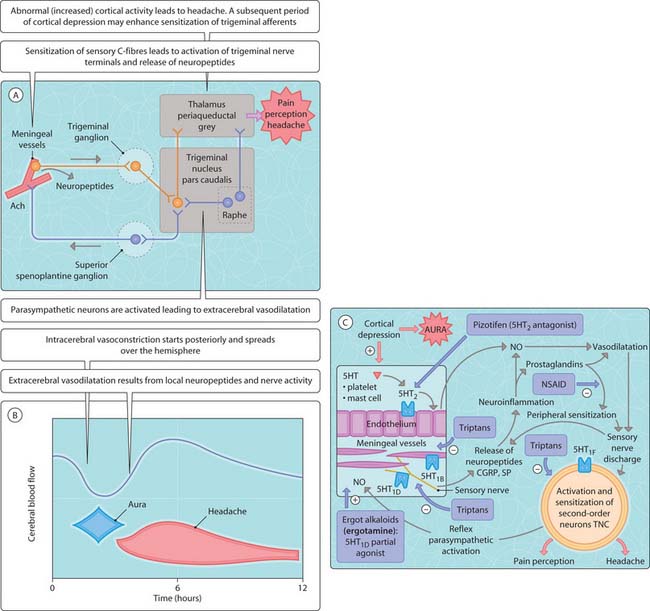40 Migraine
Migraine is characterized by pulsating severe headache of long duration (4–72 h) and is often accompanied by nausea and sensitivity to light, sound or movement (common migraine). At least 20% of patients suffer from migraine with aura (classic migraine) and this is preceded by neurological symptoms (e.g. visual). These features distinguish migraine from tension-type headache, the most common form of primary headache. The mechanisms underlying a migraine are thought to arise as a combination of cranial vessel constriction (aura) and dilatation (pain, headache), although it is clear that cerebral blood flow is altered during a migraine attack. During an attack, there is a brief wave of intense cortical stimulation followed by marked depression of cortical activity, which lasts for up to an hour and spreads across the surface of the brain. Reduced blood flow (oligaemia) develops in this area of cortical depression, which gives rise to headache. There is also evidence that the spreading cortical depression may sensitize trigeminovascular afferent neurons, which would facilitate cranial vessel dilatation and transmission of impulses to higher centres and the expression of pain and headache (Fig. 3.40.1A).
Management of acute attacks
NSAIDs. NSAIDs (e.g. ibuprofen can be useful in the treatment of headache associated with migraine andare administered when headache is first recognized(Fig. 3.40.1C). The role of prostaglandins in sensitization of nociceptive afferent neurons is the basis for their beneficial mechanism of action. The utility of this treatment varies between patients and severity of migraine.
Ergot derivatives
Ergotamine offers a low cost approach to the treatment of acute attacks of migraine. It has a complex pharmacology and is a partial agonist at α1-adrenoceptor and 5HT1D receptors, thereby promote meningeal vasoconstriction. Ergotamine is susceptible to first pass metabolism and is more likely to induce nausea (D2 agonism in area postrema) following oral administration, which can be minimized by using it as a rectal suppository. Ergotamine is contraindicated in pregnant women and in patients with peripheral vascular disease, coronary heart disease, hypertension and impaired hepatic or renal function.
Stay updated, free articles. Join our Telegram channel

Full access? Get Clinical Tree





